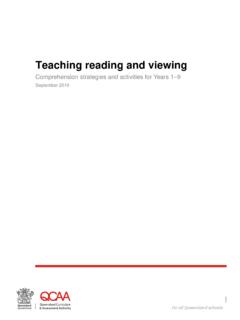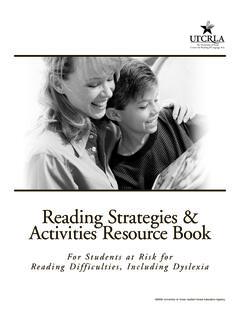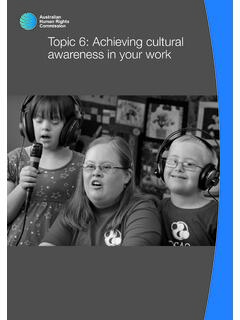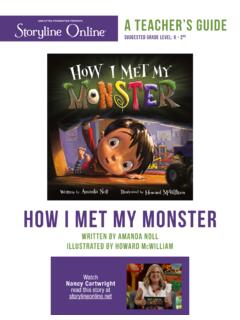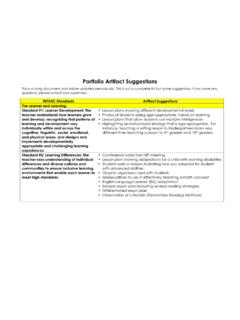Transcription of Comprehension Handbook - NSW Centre for Effective Reading
1 NSW Centre for Effective Reading Comprehension Handbook Page 1 Comprehension Handbook Contents Comprehension Background Information .. 2 Teaching Comprehension strategies .. 3 Comprehension - Strategy Instruction .. 4 The Six Stages of Strategy Instruction .. 4 The Use of Self-Regulation .. 5 Specific Strategy Instruction .. 6 Comprehension Previewing and Predicting .. 7 Comprehension Evaluating Text Structure .. 17 Comprehension Generating Questions .. 45 Generating Level 1 - Literal Questions:.. 45 Generating Level 2 Putting It Together Questions Questions.
2 52 Generating Level 3 Making Connections Questions: .. 54 Comprehension Fix-up Strategies .. 64 Reread or use fix-up strategies self monitoring .. 64 Comprehension Main Idea .. 76 Comprehension - Visualising .. 86 Comprehension - Retelling .. 98 Comprehension - Summarising .. 104 Comprehension Integrated Strategies .. 113 Comprehension Integrated Strategies .. 115 Reciprocal Teaching .. 115 Reciprocal Teaching .. 121 Reciprocal Teaching .. 121 Comprehension Integrated Strategies .. 123 Collaborative Strategic Reading (CSR) .. 123 Using Cooperative Groups .. 124 Conclusion .. 136 Middle Years NSW Centre for Effective Reading NSW Centre for Effective Reading Comprehension Handbook Page 2 Comprehension Background Information Introduction As text becomes more complicated in the middle years and high school, and as the demands for learning from text (particularly information texts)
3 Increase, students must become more sophisticated in both the range and the flexibility of their Reading Comprehension strategies to maintain or accelerate their level of Reading proficiency (Duke & Pearson, 2002, in Academic Literacy Instruction for Adolescents, 2007, ). For students with Reading difficulties -instruction in Reading Comprehension strategies is particularly relevant It is interesting to compare successful readers with struggling readers to understand how their Reading behaviours affect their understanding and recall of text. Boardman, A. G., Roberts, G., Vaughn, S., Wexler, J.
4 , Murray, C. S., & Kosanovich, M. (2008) Students with Reading difficulties are generally inactive learners (Torgesen & Licht, 1983) who fail to monitor their Reading or effectively use Comprehension strategies. Instead they tend to focus on the surface aspects of Reading or mechanical Reading . These readers do not reflect on how their Reading is progressing nor do they know which strategy to use when Comprehension breaks down. Successful Readers Struggling Readers Monitor Reading for understanding. Consider the writing from the author s view, interacting with the text during and after Reading . Link content with their prior knowledge.
5 Use a variety of Effective Reading strategies before, during and after Reading . Set a purpose for Reading and adjust their rate and strategy use depending on the text and content. Fail to use metacognitive strategies as they read. May not be aware when understanding breaks down. Do not question or interact with the text during or after Reading . May lack subject-specific prior knowledge. Do not readily make connections between what they are learning and what they already know. Have limited knowledge and use of strategies for gaining information from text. May fail to read with purpose or goals. Often do not enjoy Reading and lack understanding of the utility of Reading NSW Centre for Effective Reading Middle Years NSW Centre for Effective Reading Comprehension Handbook Page 3 Teaching Comprehension strategies Comprehension strategies are procedures that readers use to help them to understand texts.
6 These strategies include, but are not limited to, previewing and making predictions, evaluating text structure, generating and answering questions, determining main ideas, using fix-up strategies, visualising, retelling and summarizing. Comprehension strategies are employed before, during, and after Reading . Effective readers automatically employ strategies to understand what they are Reading . Some strategies are used before Reading , continue during Reading and are also applied after Reading , such as Generating questions and Making predictions . Other strategies link together.
7 For example, Previewing involves Evaluating text structure then students Activate their background knowledge to Make predictions . In doing this the student also sets a purpose for Reading to check predictions. Similarly, having learned initially how to retell, students move on to forming the main idea for each paragraph and then using these to summarise the section of text. Students with Reading difficulties need explicit instruction in how to use Comprehension strategies to assist them to understand what they read. They also require additional modelled practice and ample practice at both guided and independent levels, in using these strategies with a variety of texts.
8 The consensus is that students need to learn more than one Comprehension strategy, but it is not clear how many strategies can be effectively taught in any given period of time. The answer will likely vary, depending on teacher s skill, student abilities, instructional group size, and the time available for instruction (Torgesen, J. K., Houston, D. D., Rissman, L. M., Decker, S. M., Roberts, G., Vaughn, S., Wexler, J. Francis, D. J, Rivera, M. O., Lesaux, N., 2007, p. 28). A variety of single strategies can be integrated to form multiple strategies. These integrated strategies provide a process that can be used in cooperative groups or used in pairs or individually.
9 Training in the integrated strategies or multiple strategies has proven to be very successful in improving reader s Comprehension . Examples of integrated strategies include Reciprocal Teaching and Collaborative Strategic Reading as well as others. The goal of this Handbook is to bring together many of these strategies and provide teaching steps and some teaching examples to provide teachers of Middle Years students with sufficient information to allow them to develop their students Comprehension skills. It is to be noted that the Sequence of skills developed for most strategies is not research-based but one possible attempt to task analyse the skills involved to learn the strategy.
10 References Boardman, A. G., Roberts, G., Vaughn, S., Wexler, J., Murray, C. S., & Kosanovich, M. (2008). Effective instruction for adolescent struggling readers: A practice brief. Portsmouth, NH: RMC Research Corporation, Center on Instruction. Coyne, , Kame enui, & Carnine, (2007). Effective teaching strategies that accommodate diverse learners (Third Edition), Pearson: New jersey. Denton, C., Bryan, D., Wexler, J., Reed, D. Vaughn, S. (2007) Effective instruction for middle school students with Reading difficulties: The Reading teacher s sourcebook. University of Texas Systems/Texas Education Agency Kamil, M.


